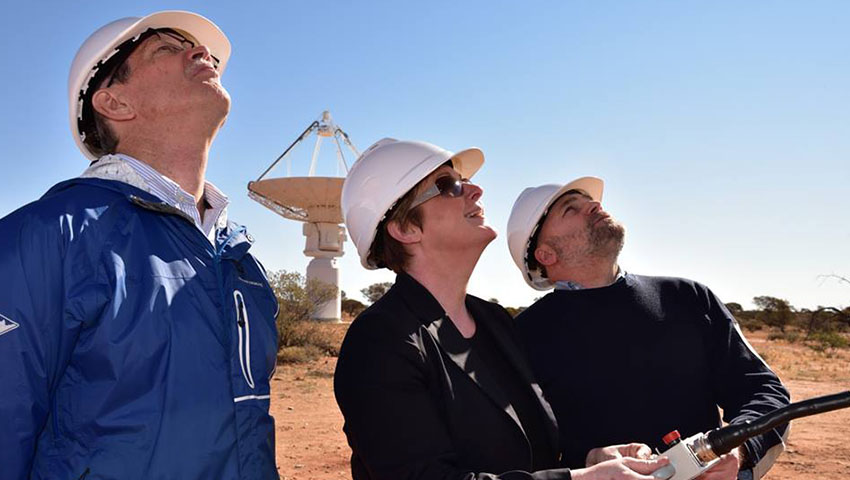Defence Minister Linda Reynolds has issued a ministerial statement highlighting the growing importance of space to Australia’s economic and broader national security and outlining the government’s plans for growing the nation’s sovereign space capabilities.
Sovereign space capabilities have emerged as one of the key priorities as identified by the government as part of the 2020 Defence Strategic Update and the support 2020 Force Structure Plan.
Supporting this, Prime Minister Scott Morrison outlined $7 billion to develop space capabilities to include: "Investment of around $7 billion in space capabilities over the next decade, which includes investment in sovereign-controlled satellites, will provide assured access to these services when needed."
This capability will support "satellite communications and position, navigation and timing data are essential for the command and control of deployed forces".
"These systems enable the sharing of real-time operational and logistical information and or the placement, navigation and synchronisation of Defence assets," the government said.
Additionally, Australia will expand its support of space situational awareness capabilities with the US to maximise the integration and capabilities of existing and planned space-based intelligence, surveillance, reconnaissance and communications capabilities in the increasingly contested space domain.
Supporting this growing push to develop sovereign space capabilities, Defence Minister Linda Reynolds has expanded on the Prime Minister's statements, to not only explain the importance of space capabilities, but identifying the government's plans moving forward.
"As Defence Minister, I have seen first-hand how space technology has saved lives. During the bushfires and COVID-19 we have used vital, space-enabled technology, including global positioning systems, satellite communications and imagery, to help us efficiently deliver emergency responses to Australian communities," Minister Reynolds explained.
"And in conflict, Defence uses space technology to communicate with deployed forces, giving them real-time information to help them protect Australian interests. Put simply, space technology is life-changing and life-saving. So it is vital that Australia retains a technological edge so we can protect our national interests and our freedom to access space.
"But space is becoming more congested and contested. With more than 2,600 satellites orbiting the Earth, and more being launched every year, the co-ordination of safe access to space is complex. We must maintain access to protect of billions of dollars’ worth of military and commercial assets against space debris, collisions and malign acts.
"This is why the Prime Minister and I have announced the investment of $7 billion over the next decade in space capabilities as part of the 2020 Defence Strategic Update and 2020 Force Structure Plan."
Expanding on these key points, Minister Reynolds stressed the continued importance of investing in sovereign space capabilities, clearly articulating the government plan for 2035.
"The Morrison government is taking the first step towards introducing Australia’s first fully owned and controlled military satellite-communications constellation," she said.
"In addition, we will strengthen our sovereign capability by building upon existing plans to develop overhead imagery capability by 2035. This will provide a greater understanding of the Indo‑Pacific.
"Our plans also include enhancing Australian Defence Force space control capabilities to counter emerging space threats to Australia’s free use of the space domain. This will assure our continued access to space-based communications, intelligence, surveillance and reconnaissance."
As with other areas of defence co-operation, Australia's development of sovereign space capabilities will focus on developing collaborative research and development relationships with key allies, including the US, UK and other nations.
"To ensure a co-ordinated and targeted approach to capability and policy decisions, the ADF space domain will sit within the Royal Australian Air Force, led by the Chief of Air Force," Minister Reynolds explained.
"Secondly, Australia is deepening co-operative relationships with key international partners and allies. While our sovereign capabilities are growing, we achieve far more when we work in collaboration with close partners.
"This is demonstrated through Operation DYURRA – a dedicated ADF space operation that will integrate space capabilities, services and effects into wider ADF operations. DYURRA is the word for 'stars' in the Ngunnawal language.
"Operation DYURRA also includes integration of ADF space operations with our partners through the US-led Operation OLYMPIC DEFENDER. This operation enhances allied cooperation to strengthen deterrence against hostile actors, improve their interoperability, and reduce the spread of debris.
"Defence is also working with the US, United Kingdom, Canada, New Zealand, France and Germany through the Combined Space Operations Initiative to strengthen norms and standards of behaviour and to leverage our combined capabilities."
Finally, Minister Reynolds expanded on the existing investments initiated by the government in key tactical and strategic force-multiplying space capabilities, saying, "I was proud to commit $87 million to boost our vital Defence facilities in Exmouth this week, when I visited two facilities which house critical space technology.The C-Band Radar and the Space Surveillance Telescope in Exmouth are central to our space domain awareness efforts with the United States.
"This impressive technology is just part of a burgeoning space enterprise in our State. In the Murchison, the Square Kilometre Array, which is co-hosted by WA and South Africa is already unlocking secrets of the universe. Curtin and UWA have formed the International Centre for Radio Astronomy Research, while the Pawsey Supercomputing Centre in Bentley gives us homegrown, big data capability.
"Add the Murchison Widefield Array, the Desert Fireball Network, the European Space Agency's deep space antenna in New Norcia, the Perth International Telecommunications Centre, the Western Australian Space Centre and the Learmonth Solar Observatory, and it is clear WA plays a vital role in the national space industry and international co-operation.
"With the perfect combination of low population density, minimal electromagnetic interference and good air quality, WA is ideal for radio antenna, telescopes and other sensitive electronic measuring devices needed for both civilian and defence space projects.
"Space is truly the new frontier of both global competition and cooperation."


